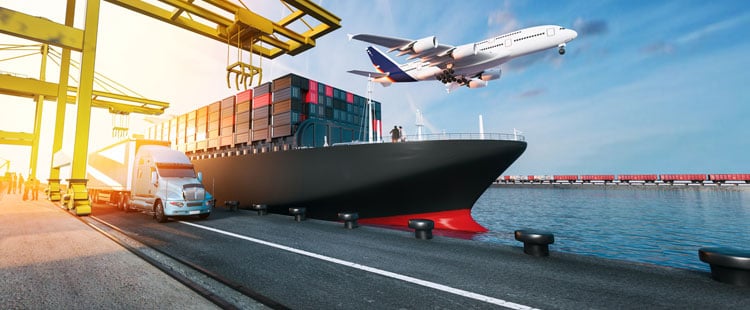
It’s been a challenging year for the shipping industry, and next year promises to be equally tricky.
With pending duty rate increases, a developing trade war between China and the United States, and looming bunker fuel regulations, it will take a new level of preparation and planning to stay ahead in 2019. As with any substantial change, there will be early-adapters that will set the tone for years to come, while others wait until the last minute to adjust their strategy.
Which side of the spectrum will your company fall on?
Duty Rate Increase

It’s no secret that many companies have pushed hard to bring their products stateside before January 1st.
This action is less a response to new tariffs as it is a hedge against the new duty rates set to take effect in early 2019. While it’s hard to predict whether or not these new rates will go through, industry analysts have already developed scenarios for how this will impact rates and logistics in the coming years.
Because so many companies moved their products to beat the duty increase, it’s possible there will be a sharp decline in demand for specific items and an increased demand for viable storage space.
Warehouses are likely full of overstocked inventory which has to move before they can process new orders. If we do end up facing a downtrend, it’s unclear how the shipping lines will react. It’s possible they could choose to remove lines from the market, reducing capacity in an attempt to stabilize supply and demand.
Either way, if demand drops, there will likely be a significant and prolonged period of depressed rates. Companies with well-stocked warehouses are going to be taking a wait-and-see approach, especially if shipping lines try to artificially maintain higher rates.
Your company could benefit by placing orders during this new “slow” season. It’s essentially the inverse scenario to the current one. Better to over-supply when demand is low than wait for it to return to normal levels.
Warehouse management systems, production planning, and forecasting tools make excellent tools to gauge your stock levels and plan accordingly. Meanwhile, balancing tariff updates with the freight spot market may be a 2019 best practice.
New Regulations On Bunker Fuel
The International Maritime Organization (IMO) announced new rules for high-sulfur fuel oil (HSFO) that will take effect in 2020. The shipping industry is expected to reduce emissions by more than 80% in order to meet compliance regulations.
Some shipping lines are pre-emptively installing exhaust cleaning systems to avoid a total transition to low-sulfur fuel. These systems, called scrubbers, will allow some vessels to continue burning HSFO beyond 2020. However, not all shipowners are expected to take this route.
Currently, the marine sector accounts for nearly 50% of global fuel oil demand. According to Reuters, these new regulations could lead to a spike in shipping fuel costs. Analysts are saying a best-case scenario for the overall cost increase throughout the industry is an additional $24 billion added to the current $100 billion spent annually on shipping fuel.
Nearly a 25% spike. Unfortunately, shipping lines will pass any high-grade fuel charges onto the customer. You are going to have to prepare for an increase in your overall logistics cost. Let your superiors know of this so they can anticipate the expense.
Developing Relationships With Non-Chinese Manufacturers
Should China and the United States not reach some agreement, companies will have to find alternative sources for their products.
However, many Chinese companies are responding to the tariffs by moving their manufacturing operations to different locations – or, at least, seriously considering it.

While the tariffs have accelerated this trend, it’s not a new one. In 2010, a wage increase forced many Chinese manufacturers to find cheaper labor in countries like Thailand and Taiwan. Now, these same companies are beginning to explore options that avoid Chinese ports, including Vietnam, Mexico, and Brazil.
Regardless of where the new ports are, it’s important to recognize how well-developed China’s import/export system is as compared to other developing countries. While you might be able to maintain the fundamentals of your supply chain, the timelines, likelihood of damage or loss, and other growing pains China has worked out of its process are likely to re-emerge.
If and when these changes occur, you will need to reevaluate your contingency plans related to each of the different aspects of your shipping process.
A continuing trade war could also impact the supply and demand of suitable manufacturers.
For example, if you have a partner in China who makes baseball bats but is now too expensive because of tariffs, you need to find an alternative. But that means every other person needing a high-quality baseball bat is looking for a different option as well. This increases the likelihood that top-of-the-line manufacturers in alternative countries will be at full capacity, which could lead to delivery problems or quality issues. Both of these factors can have rippling negative implications for your business.
Importers will be faced with the decision of whether to stick with China and endure the price increases, hoping that it will be short-term, or invest in developing relationships and processes with manufacturers in countries that have a less mature infrastructure like India.
Continued Economic Growth?
People in our industry are split as to how the current U.S. trade war with China will resolve.
Some see it as a good thing that will shock prices back to a more reasonable level, while others are preparing for a long-term change in how we do business. It’s possible this will resolve itself within six months, and we’ll return to a slightly modified business-as-usual. It’s hard to fathom it lasting any longer, especially with the effect it has on global economy and business overall.
However, it’s a good idea to look for alternative sources of manufacturing outside of China, while continuing to work with your existing partners. You should also plan for the contingencies that come with building new import/export relationships and create strategies to help counter the inevitable pitfalls in case you need to utilize new partners.



